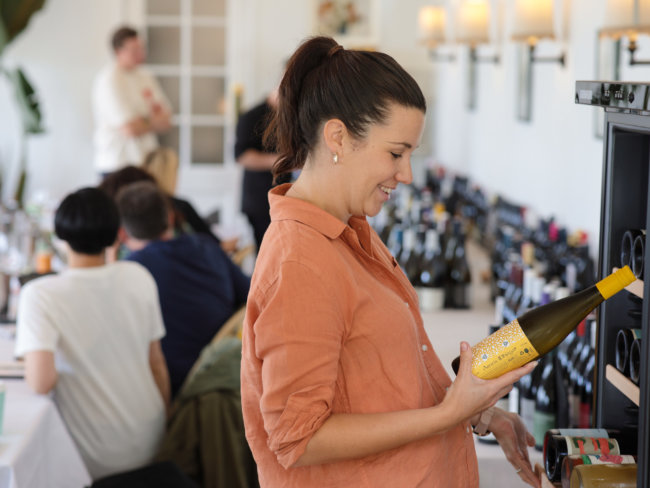It hasn’t been that cool to like pinot gris. It certainly doesn’t enjoy the best rep among wine’s taste makers. And, in fact, it’s been up against it from the start in Australia.
It was first brought into the country by viticulturist Max Loader in the 1970s. Loader was working with Brian Croser at the time, and somehow managed to win their debate about importing it: “Max was an ardent champion of the variety, much to my scepticism. I always thought it a mundane version of the real thing, pinot noir, and said so to Max.”
Pinot gris is a mutation of pinot noir, and the berries on a single bunch can vary in colour. It is darker than other ‘white’ grapes, throwing pink and grey colours. Today, some Australian producers are embracing this and are producing coloured, textural wines as a result from the non-conventional method of making a skin-contact pinot gris.
Gris or grigio?
But even before thinking about the colour spectrum of the variety, there’s also the whole ‘Gris or Grigio’ confusion to consider. Pinot gris and pinot grigio are synonyms for the same grape. The decision on what to label a wine has usually been a marketing toss of the coin, and not always a reflection of the origins of either name.
Pinot gris is most associated with wines coming from Alsace, France, where the grapes are picked riper to achieve a richer style. Pinot grigio is the Italian name, where the grapes are generally picked earlier, and the style is typically dryer and crisper.
Back in 2010, the AWRI developed a ‘Pinot G Style Spectrum’, a visual scale for wine labels that could provide consumers guidance on what style of wine was in the bottle. A practical approach, but one that wasn’t universally adopted by producers and has since fallen away.
Peninsula Gris
Ocean Eight and Polperro recently held a benchmark tasting of Mornington Peninsula pinot gris against other leading examples from around the world, particularly from Alsace.
The local wines looked terrific. Mike Aylward of Ocean Eight explains why: “Here, on the Mornington Peninsula, the work and detail that is going into pinot noir is rubbing off onto pinot gris. We are growing pinot gris vines alongside our rows of chardonnay and pinot noir, and cultivating the vines the same way. We’re making pinot gris like Burgundy.”
The wine tasting also highlighted the variety’s suitability to the aromatic and spicy dishes of Asia. Which is in contrast to the general school of thought among sommeliers that Riesling is the best accompaniment to Asian food.
![]()
Pinot Gris paired with Vietnamese dishes by Chef Jerry Mai at Annam
Asian connection
Ned Goodwin MW is the wine consultant to All Nippon Airways for First and Business Classes, and is an importer of Australian wine into Japan, so he’s ideally situated to gauge what wines work best with their food culture. “Riesling with Southeast Asian food is a fallacy. We’ve had it pushed down our throats that riesling goes well, but it doesn’t go well at all. The higher acidity exacerbates chilli heat and pungency. Pinot gris, conversely, is fairly low acid; is fairly neutral; it has a textural complexity about it, but it just doesn’t get in the way. Wine augmenting the food dish is very much a western notion. The Japanese often talk about wines that don’t get in the way of food. That’s what pinot gris does very well.”
Adam D’Sylva, chef of Coda and Tonka restaurants in Melbourne, agrees: “Thailand, Vietnam and India are countries where beer is more commonly the accompaniment to food. But I’ve found pinot gris matches my repertoire well. Ingredients like ginger, coriander and lemongrass are the basis of all my dishes. To be able to pair food with delicate wines like pinot gris, which can handle spice and aromatics, is great.”
The Cool Hunt
With the rise and rise of the Asian dining influence in Australia, there’s so much potential for quality expressions of this variety, such as those from the Mornington Peninsula, to establish more of a ‘cool’ footing in the market. But could pinot gris overtake sauvignon blanc as the top selling white in Australia?
Samantha Payne, Sydney-based consultant sommelier to around ten upmarket venues across Queensland and New South Wales, says it’s already happening: “A lot more people are asking for pinot gris/grigio over sauvignon blanc. Sauv blanc used to be the standard thing, but not so much anymore. It’s a trend. It’s definitely surpassed sauv blanc as my top-selling white across the board.”
However, Aylward might not like the idea of pinot gris taking off that much, because boutique producers like Ocean Eight are only ever going to make a small production. It’s the volume players that exploit the trends. As Malcolm Gladwell pointed out, “the act of discovering what’s cool is what causes cool to move on.”
It’s a nice conundrum to consider, though, and one that shows how far pinot gris has come in Australia. As Croser reflects, “Max was correct. He was a very determined and thoughtful character and should be remembered for his commitment to pinot gris.”
Whatever happens, Max Loader would be thrilled with the quality and diversity of Australian pinot gris today.
Ocean Eight is a partner of the Wineslinger Awards






